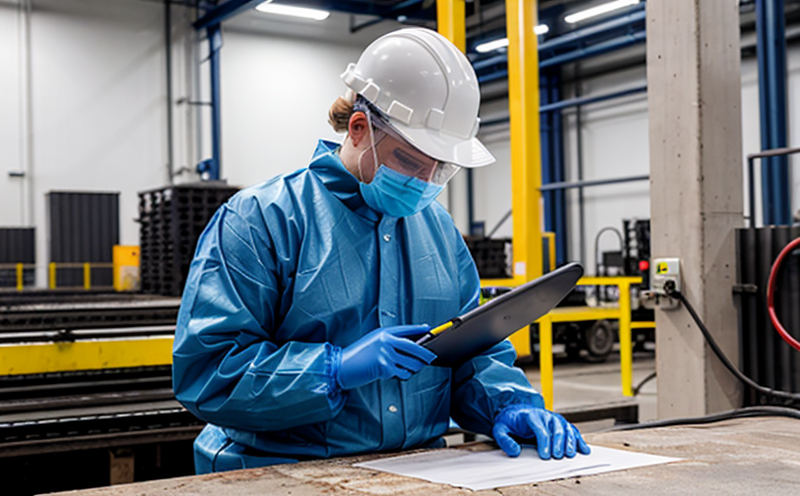ISO 9612 Noise Exposure Measurement Testing in Factories
The ISO 9612 standard provides a framework for measuring and assessing noise exposure levels in industrial environments, particularly focusing on factory settings. This service ensures that employers comply with occupational health and safety regulations aimed at preventing hearing damage and other adverse effects of excessive noise. The testing process involves several critical steps to accurately measure the ambient noise levels and determine the cumulative noise exposure over time.
The first step is setting up the measurement environment, which typically includes placing sound level meters in strategic locations around the factory floor. These devices are calibrated according to ISO 9612 standards to ensure accuracy. The testing period varies depending on the nature of the operations but often spans several days or weeks to capture all relevant noise events.
Once data is collected, it undergoes rigorous analysis using software that applies the ISO 9612 algorithms for calculating equivalent continuous sound levels (Leq). This calculation considers both the peak decibel levels and the duration of exposure. The results are then compared against permissible noise level limits specified in the relevant regulations.
Compliance with these standards is crucial not only to avoid legal penalties but also to protect workers' health. Continuous monitoring helps identify high-risk areas where improvements can be made, such as installing sound barriers or modifying machinery. Additionally, this service assists in designing effective hearing protection programs tailored to each factory's unique noise profile.
The importance of accurate measurement cannot be overstated; even slight variations in how measurements are taken could lead to misinterpretation of results. Therefore, adhering strictly to ISO 9612 guidelines ensures consistent and reliable data which is essential for making informed decisions regarding workplace improvements.
For industries where noise levels exceed safe thresholds, implementing control measures becomes paramount. Our team works closely with clients to implement these solutions effectively while maintaining productivity levels. By leveraging advanced technology and methodologies outlined in ISO 9612, we provide comprehensive support throughout the entire process from initial setup to final analysis.
Understanding that every factory has its own specific challenges when it comes to noise management, our approach is tailored specifically for each client's needs. We conduct thorough assessments before recommending appropriate actions based on findings from our detailed measurements and analyses.
Industry Applications
| Industry Sector | Application Example |
|---|---|
| Automotive Manufacturing | Measuring noise levels in assembly lines to ensure worker safety. |
| Petrochemical Processing | Evaluating ambient sound conditions near reactors and storage tanks. |
| Metal Fabrication | Assessing noise generated during cutting operations within confined spaces. |
| Food and Beverage Processing | Determining appropriate hearing protection requirements for warehouse staff. |
In automotive manufacturing, it's essential to monitor noise levels closely because workers spend long hours in noisy environments. By using ISO 9612 compliant tools, we can help identify problem areas and suggest solutions that minimize risks without compromising production efficiency.
Petrochemical processing plants often face unique challenges due to the high-intensity sounds produced by various equipment. Our testing helps determine safe zones for personnel while ensuring all necessary safety protocols are followed.
Metal fabrication facilities frequently experience loud noises from machinery like saws and presses. Understanding these environments allows us to recommend effective noise reduction strategies that enhance both worker comfort and overall productivity.
Food and beverage processing warehouses can also benefit significantly by understanding the acoustic environment within their structures. Properly fitted hearing protection is crucial here, especially when dealing with large open spaces where echoes play a significant role in perceived volume levels.
Quality and Reliability Assurance
The reliability of our measurements directly impacts the quality assurance processes implemented by manufacturers across different sectors. By providing accurate noise exposure data, we contribute significantly to maintaining high standards within factories worldwide.
Achieving compliance with ISO 9612 means more than just meeting regulatory requirements; it sets a benchmark for excellence in occupational health and safety practices. Regular assessments enable continuous improvement initiatives aimed at reducing unnecessary risks associated with excessive noise levels.
Our commitment to quality extends beyond mere testing; we offer extensive training programs designed specifically for personnel responsible for conducting these tests internally or overseeing external audits conducted by third parties.
Incorporating ISO 9612 into your overall strategy demonstrates a proactive approach towards safeguarding employee welfare. It shows that management values the importance of creating safe working conditions where everyone can perform their tasks effectively without being exposed to harmful levels of noise.
Use Cases and Application Examples
| Use Case | Description |
|---|---|
| Evaluating New Machinery | Determining whether newly acquired equipment complies with noise limits. |
| Identifying Problem Areas | Locating specific areas where noise levels exceed permissible thresholds. |
| Implementing Control Measures | Suggesting modifications to existing processes or introducing new technologies to reduce noise. |
| Educational Purposes | Training future professionals in proper measurement techniques and interpretation of results. |
Evaluating newly acquired machinery is crucial before integrating it into an operational environment. Our testing ensures that any new equipment introduced does not violate existing noise regulations, thereby protecting both workers' health and the company's reputation.
Identifying problem areas enables targeted interventions focused on reducing noise levels where they are most critical. This approach allows for more efficient allocation of resources towards addressing the worst offenders first.
Implementing control measures based on our findings helps create safer working environments by introducing new practices or upgrading current ones. These actions may include relocating noisy equipment, installing soundproof enclosures, or providing additional hearing protection devices.
Educational purposes serve not only current employees but also students learning about industrial hygiene and safety standards. By participating in real-world testing scenarios, they gain practical experience that enhances their theoretical knowledge.





